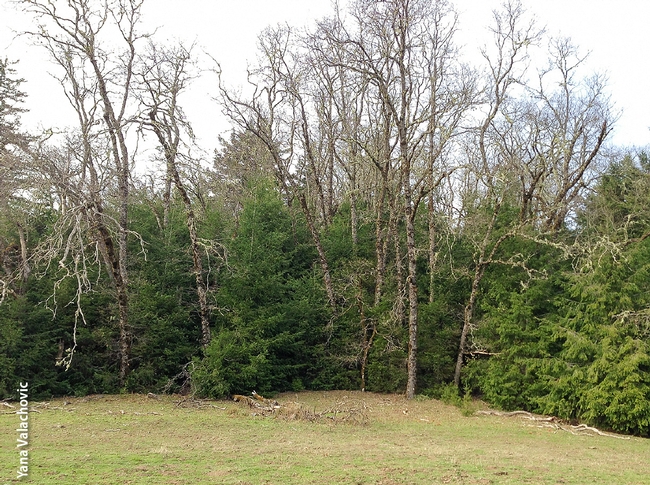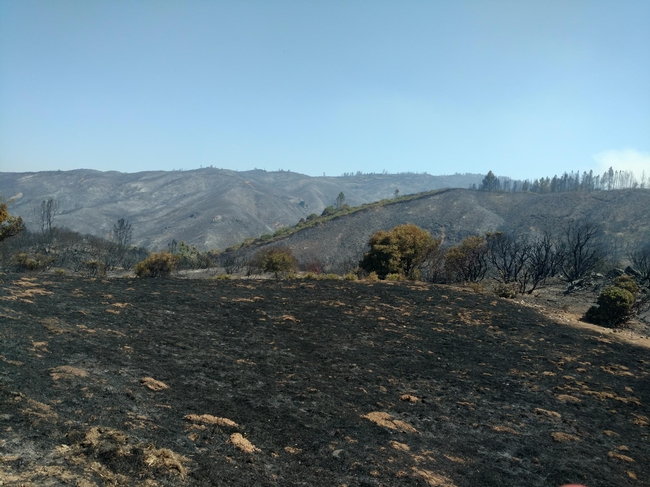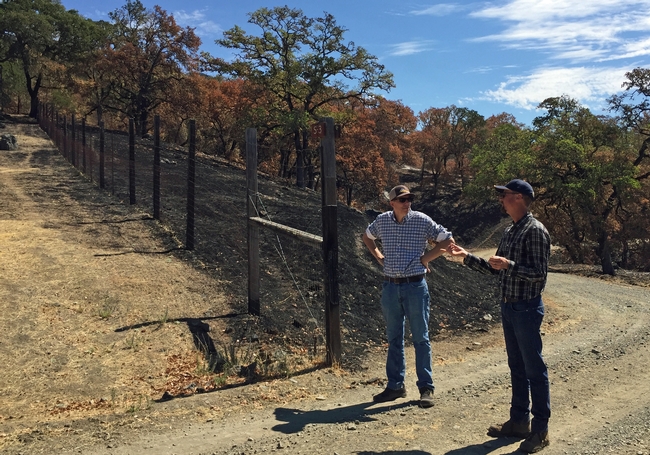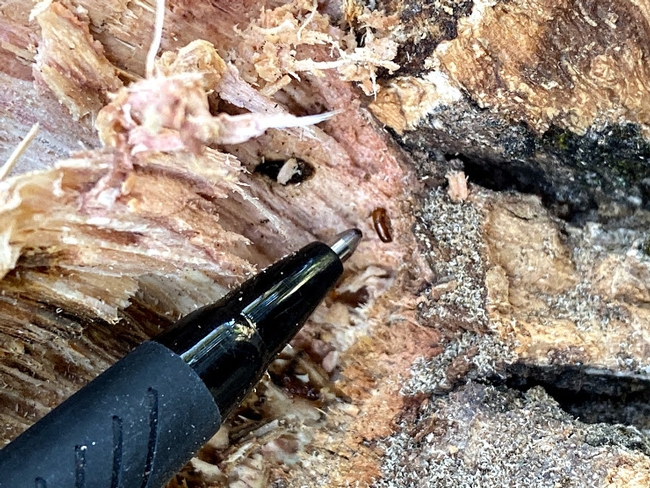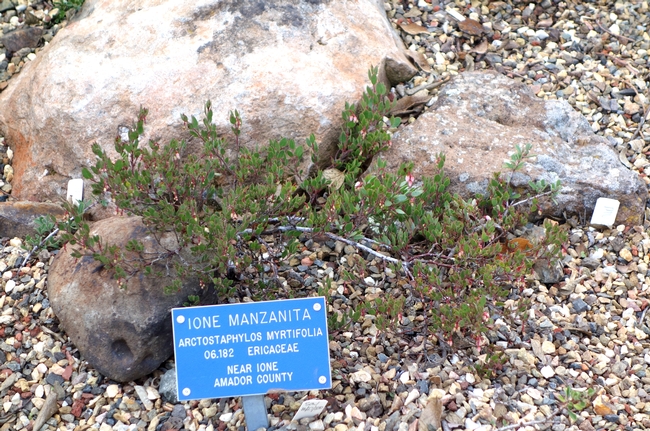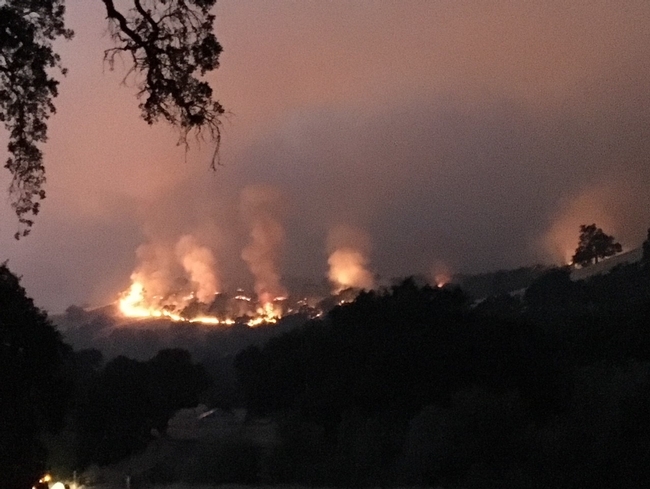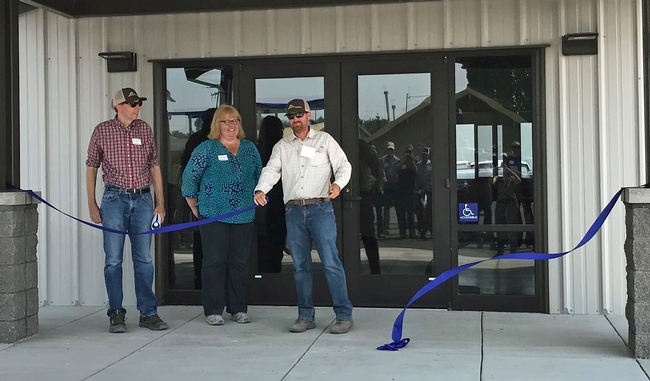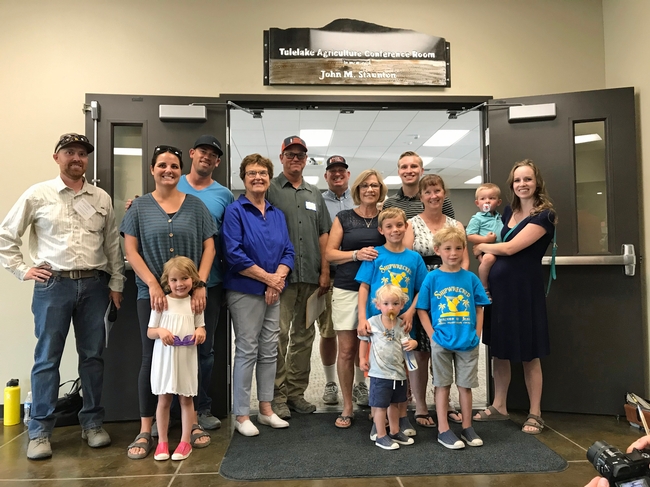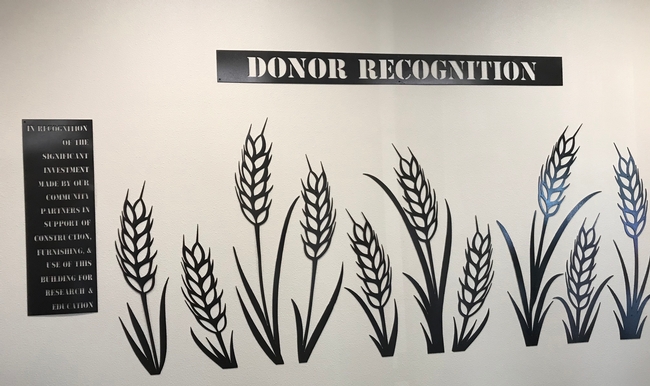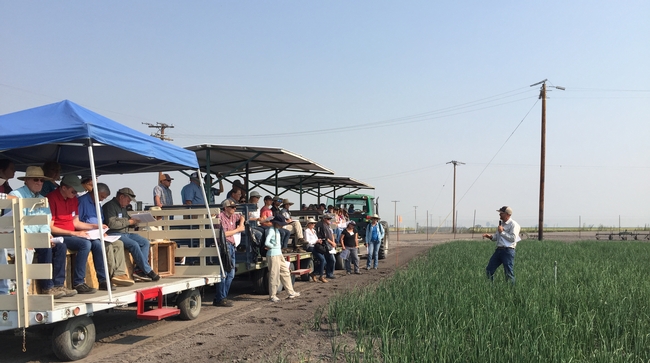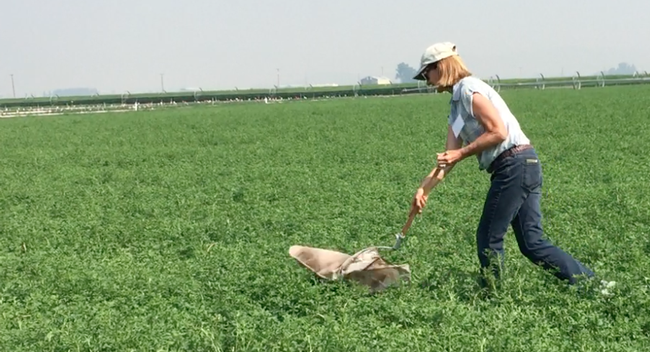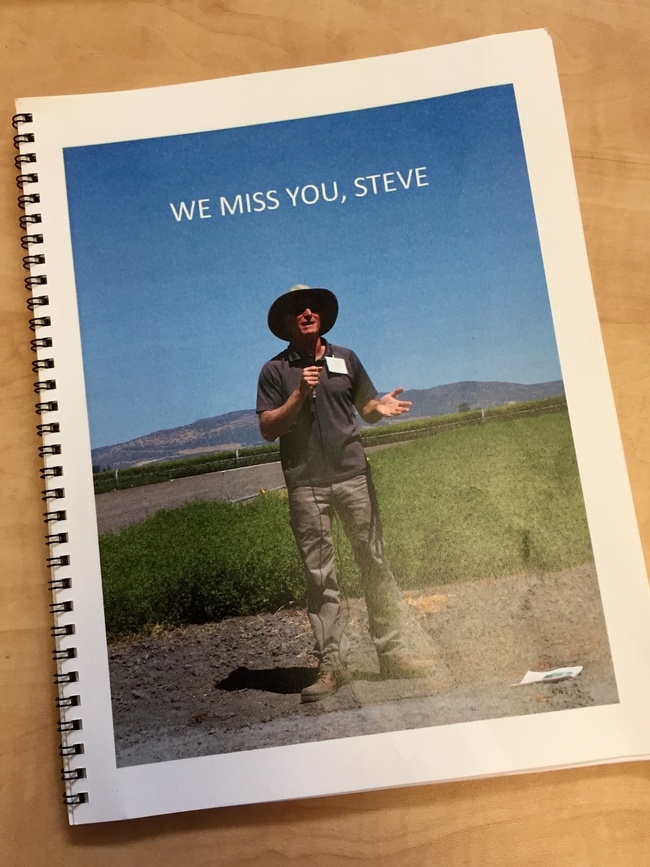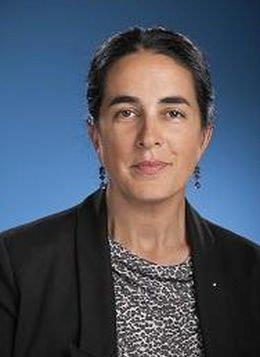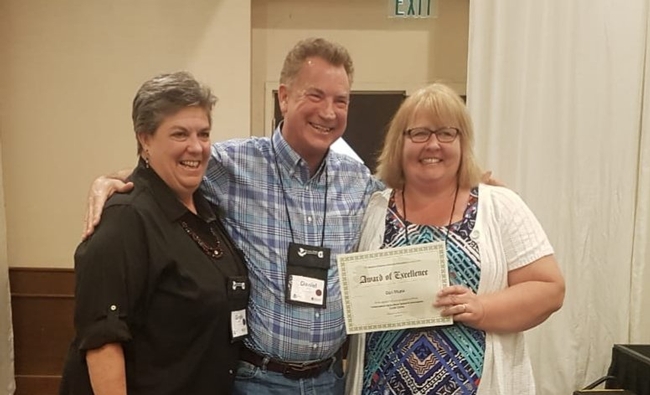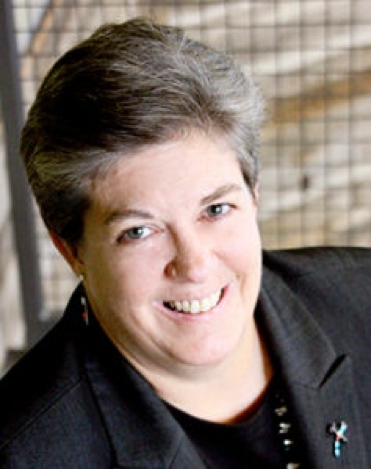Posts Tagged: Oak Woodlands
Hundreds sign up for online oak woodland workshop
California oak woodlands are highly prized ecoregions where stately trees, many of them hundreds of years old, are cornerstones of a habitat for wildlife and native plants. Sadly, some of these ecosystems are seriously threatened by exotic pests and diseases, encroachment by less desirable vegetation, and wildfire.
Each year, UC Cooperative Extension hosts workshops to share scientific developments aimed at conserving these important habitats – and the economic value of ranching – on oak woodlands, which are found on the lower elevation slopes of the Sierra Nevada, the Coast Range and other foothill areas of California.
Typically, the workshops are held in person and draw moderate-sized audiences for presentations, questions and answers, and field trips. Because of the COVID-19 pandemic, this year's workshop was offered online in April with pre-recorded presentations available for viewing at the participants' convenience and a live question-and-answer session on Zoom.
The retooled event garnered 500 registrants, over 300 views of the YouTube videos and 140 participants in the live Q&A session. The presentations and Q&A session are still available online for future viewing as well.
“People from all walks of life participated, including those with professional and personal interest in oak woodlands,” said Yana Valachovic, UCCE forest advisor in Humboldt and Del Norte counties and a conference organizer.
Presentations at the 2020 conference included the following topics:
Encroachment by Douglas-fir
In Northern California, the biodiversity of oak woodlands is being threatened by Douglas-fir encroachment. The oaks' shade helps the young conifers get established with protection from harsh sun. In time, the fast-growing Douglas-fir trees pierce the oak canopies and begin to crowd out the areas' native understories, which are important for the diversity of birds, mammals and reptiles attracted to oaks.
As the Douglas-fir continue to grow and multiply, they threaten the very lives of the oak trees and the unique ecosystem they dominate.
To better understand the Douglas-fir encroachment, Valachovic established 10 research sites in Humboldt and Mendocino counties to gather information about the fate and the age of oaks. She and her research partners determined the ages of the oaks and firs, and counted the seedlings, saplings, snags and understory vegetation.
“With this research, we were able to demonstrate that even though the oak trees can be smaller in diameter they are much older than the Douglas-fir trees,” Valachovic said. “The encroachment process is happening quickly, and the oaks are falling out of the system.”
The shift appears to have been initiated in the mid-19th and early-20th centuries, coinciding with the Gold Rush and wildfire suppression.
With the data confirming Douglas-fir encroachment, Valachovic turned her attention to oak woodland restoration. At 14 sites in Humboldt and Trinity counties, her team studied the effects of Douglas-fir removal.
“Grasses and forbs under the oaks reestablished. Diameter growth on the oaks increased,” she said.
These research findings contributed directly to changes in policy that had previously limited land owners' ability to remove and sell conifers encroaching on oak woodland. The research also helped create new funding opportunities to support oak woodland restoration and conservation in Northern California.
Case study of oak woodland wildfire recovery
In July 2018, about two-thirds of the 5,289-acre UC Hopland Research and Extension Center was burned by the River Fire.
The transformation of the land, which had likely been without a large wildland fire for at least 100 years, was intense and stressful, said UC Cooperative Extension forest advisor Michael Jones. However, it also provided a unique opportunity for researchers to compare the impact of wildfire on the resiliency of vegetation on grazed and ungrazed oak woodland.
Jones established 35 one-fifth acre research plots at the research center and collected data two months following the fire and one year later. The research will continue in the future to better understand long-term impacts, but Jones was able to share revealing early results at the workshop.
Right after the fire, in severely burned areas areas, the future of the oaks looked ominous. Jones predicted 40% tree mortality.
“The oaks were exposed to persistent, intense heat. They were cooked,” he said. “But two months after the fire, we were already seeing basal sprouts. This was an amazing response by the trees. Oaks are pretty damn tough.”
A year after the fire, surveys showed that tree mortality in the burned areas was 25%, much less than Jones' early predictions. While some management for specific situations in severely burned areas may be necessary – such as removal of hazard trees, reducing fuels in defensible spaces or removal to control invasive species – the results of this work show the trees recover naturally.
“Esthetically, I know these systems aren't as pleasing as they were before, but ecologically, they are healthy and recovering,” he said. “In 100 years, it will look just as good as before the fire.”
Fire impacts in woodland areas previously grazed and not grazed
The fire on the research station also permitted Jones to compare the fire's differing impact on non-grazed and grazed oak woodland. At first, the grazed areas looked almost unscathed with minimal flame scorching on the bark, while an area where the pasture hadn't been grazed for 25 years had evidence of much higher severity fire.
“Grazing is a phenomenal way to help manage fuels,” Jones said. However, the grazed areas displayed ecological shortcomings a year later.
“In grazed pastures, the large mature trees were still alive, but there was no oak regeneration (basal sprouting or seedlings),” Jones said. “In the ungrazed area, a lot of biomass had been killed, but there's nearly 100% resprout of oak trees and we have an impressive amount of oak seedling recruitment.”
Jones said he isn't discouraging grazing.
“But it is important to protect sites from grazing, and especially wildlife browse, when a landowner or land managers' objectives are to regenerate or conserve oak woodlands,” Jones said.
New ambrosia beetle another threat to California oaks
Akif Eskalen, UC Cooperative Extension specialist in the Department of Plant Pathology at UC Davis, has identified a new insect-fungus team that causes oak borer wilt in Northern California Valley and Blue Oaks. It is an ambrosia beetle, commonly known as Mediterranean Oak Borer, which carries several fungi in its mouth. The beetle bores into the tree and introduces fungi to grow for food. The fungi spreads and disturbs the transportation of water and nutrients, causing wilt in the tree.
The oozing and staining lesions on the bark are similar to other oak fungal diseases, such as Sudden Oak Death. The beetle – native of Mediterranean basin countries in Africa, Asia and Europe – cannot fly far, so most likely is transported for long distances on infested firewood.
During the workshop, Eskalen suggested not moving firewood, removing heavily infested trees and chipping infested wood into 1-inch particles to reduce the spread of the ambrosia beetle and its fungal partner. He asked viewers to report any suspected oak tree infestations to the local agricultural commissioner, CDFA Diagnostic Laboratories, UC Cooperative Extension advisors or CALFIRE. Chemical options for sparing oaks from the ambrosia beetles' devastation are under investigation.
Threats to oaks and other native plants from root rotting Phytophthora
Restoration plantings have inadvertently introduced plant pathogens to native oak woodland ecosystems in California, said Ted Swiecki of Phytosphere Research, an organization that provides consulting services related to natural resource management, horticulture, urban forestry, and agriculture. The group of pathogens causing the damage are largely from the Phytophthora genus, first described in the 1860s. The name translates from Greek to “plant destroyer.”
Swiecki has observed when Phytophthora infested plants and soils are introduced to native habitats, the pathogens can attack various native plants, including toyon, madrone, manzanita and full-grown oaks. Once established, the pathogen can spread along drainages, by moving soil from one area to another and by hitchhiking on equipment, tires and hiking boots.
The pathogen can easily be overlooked at nurseries, which, by their nature, have conditions that favor Phytophthora development. Plants at nurseries are well watered, have high root density and are often placed on the ground where they can pick up pathogens.
He said the best approach to tackling Phytophthora is not using nursery stock for restoration or beautification of natural oak woodland. Direct seeding, using natural regeneration, or onsite propagation are safer ways to enhance vegetation in oak woodland.
“It's easier to prevent Phytophthora from being introduced in the first place and much cheaper and more effective than trying to eradicate it later,” Siewcki said.
Wildfire impacts ANR community
There are 19 wildfires threatening communities all over the state and causing concern for our friends and colleagues. We've been in touch with our colleagues in the fire zones and everyone is safe and, as far as we know, no ANR members have lost homes. Here's an update from the affected areas.
In Lake County, the UCCE office is closed and staff members have been evacuated from their homes since Saturday due to the Mendocino Complex fires.
Hopland REC was hit hard by the River Fire. The good news is the evacuation order was lifted Monday and all Hopland Research and Extension Center employees are safe and the headquarter buildings are undamaged. The guard dog that had gone missing has been found. The animals were moved on Friday and all livestock are safe and accounted for. Roughly 2500 acres of the upper pastures burned and the domestic water line from the spring is down. On Friday, Cal Fire set up Incident Command Post at Hopland REC with 6+ engines, three bulldozers and a water tanker. Kudos to John Bailey, superintendent and interim director, and staff for their efforts, which no doubt limited the damage.
UCCE Shasta office is open. Many staff members evacuated due to the massive Carr Fire. Last week, 4-H members helped relocate animals to safety. At least one 4-H family lost their home to the Carr Fire – and 4-H advisor Nate Caeton fears others he hasn't been able to contact in the West Side 4-H Club have lost homes – so the local UCCE staff is reaching out to see how they can help.
UCCE Mendocino office is open. All employees are safe and the office suffered no damage from the Ranch Fire.
UCCE Riverside office is open. A Master Gardener volunteer lost her home in Idyllwild to the Cranston Fire. UCCE Master Gardener coordinator Rosa Olaiz and the rest of the UCCE Riverside County staff are safe and are making plans to assist the volunteer.
UCCE San Bernardino office is open and all staff members are safe from the Cranston Fire.
As the fires are still active, we're continuing to monitor the situation and hope for the best.
Because emergencies can arise without warning, UC ANR Environmental Health and Safety has this Safety Note to help make plans http://safety.ucanr.edu/files/152253.pdf. You can also learn what to do before, during and after a fire at http://cesutter.ucanr.edu/LivingWithFire, a website by Kate Wilkin, UCCE forestry, fire and natural resources advisor for Sutter, Yuba, Butte and Nevada counties.
Thank you all for your hard work and dedication, especially those of you impacted by the fires.
Sincerely,
Glenda Humiston
Vice President
Intermountain REC brings state-of-the-art conferencing to Tulelake
Intermountain Research and Extension Center (IREC) celebrated the grand opening of a multipurpose conference and laboratory building on July 26. The facility will be available for use by private and public groups for business meetings, job fairs, trainings and conferences.
"The facility is the first in the Tulelake area to offer modern audio-visual infrastructure and high-speed internet connectivity capable of supporting remote presentations to stay in touch with groups from around the world," said Rob Wilson, IREC director. "We hope this facility will greatly increase the visibility and accessibility of local events and help draw more regional attention to the area."
The conference room was dedicated in honor of the late John Staunton, a local research collaborator with UC Agriculture and Natural Resources who passed away in 2015. Staunton Farms and the Staunton family donated $25,000 to support the building project and recognize the Tulelake farmer and his long-standing support of agriculture and research.
Winema Elevators/Western Milling, Sensient Natural Ingredients, Macy's Flying Service, and Basin Fertilizer also contributed support.
UC awarded approximately $2 million for this capital improvement project with funds from UC lease revenue bonds to pay for most of the building's design and construction costs, but additional support is needed to complete the project. Intermountain REC has set a fundraising goal of $100,000 to pay for tables, chairs, furnishing and lab equipment for the building.
A special UC fund has been created to collect tax-deductible contributions to be used solely for this building project. Donations over $50 will receive recognition in print and on the IREC website. Donations over $1,000 will receive recognition on the donor wall in the building entryway. Name plate recognition on the donor wall will be based on the gift amount: Gold ($2,500+), Silver ($1,750 to $2,499), and Bronze ($1,000 to $1,749). Donations can be made via check using the enclosed envelope or by credit card by visiting the IREC website at http://irec.ucanr.edu and clicking the “Make a gift” link.
The ribbon cutting followed the 2018 IREC field day, an annual event that showcases the research underway at the 140-acre facility. Charlie Pickett of USDA, UC Davis Plant Breeding Center director Charlie Brummer, UCCE farm advisors David Lile and Rachael Long and UCCE specialist Dan Putnam joined Wilson in giving research updates on the tour.
Research presentations included work on biological control of cereal leaf beetle, influence of fall harvest management of irrigated grass hays, onion white rot, managing alfalfa weevil and clover rootcucurlio, pulse crop options for theKlamath Basin, cover crops and amendments, cutting schedule effects on lowlignin alfalfa andgermplasm evaluation of alfalfa and tallfescue.
Reporter Danielle Jester, who covered the events for the Siskiyou Daily News, noted the palpable absence of the late Steve Orloff, who was a UCCE farm advisor for Siskiyou County for 25 years. “Orloff's absence was noticeably felt throughout the day,” she wrote. “He passed away in October of 2017, and his influence in Siskiyou County's ag industry was very apparent, evidenced in part by the many mentions of his name and work throughout the day. IREC paid tribute to Orloff in the final page of its field day guide, which featured a full-page image of Orloff during a previous field day, with the words, ‘We miss you, Steve.'”
In the news article, Jester also wrote, “The information gleaned through research at the IREC can be invaluable to farmers and other researchers. Through its years of experimentation, the center has helped growers develop more effective practices in a wide range of areas, from determining the crops that will grow best in the local climate, to selecting the most economically viable crops for the region, to understanding the most effective ways to manage pests and disease.”
Names in the News
Khaira to lead UC CalFresh
Kamaljeet (Kamal) Singh-Khaira has accepted the position of director of the University of California CalFresh Nutrition Education Program, also known as UC CalFresh. Singh-Khaira began her new role on June 18, 2018, succeeding David Ginsburg, who retired after leading UC CalFresh since 2008.
“We are very fortunate to have another strong leader to direct the UC CalFresh program,” said Helene Dillard, dean of the UC Davis College of Agricultural and Environmental Sciences. “Under David Ginsburg's leadership, our program has grown substantially and become a widely emulated model across the nation. Kamal Singh-Khaira—with her more than 20 years of experience developing and implementing health and active living initiatives—is ideally positioned to lead the program into the future.”
Prior to joining UC CalFresh, Singh-Khaira was an independent consultant. She previously held leadership positions with the Network for a Healthy California and the American Heart Association.
Singh-Khaira has a master's degree in community development from UC Davis and is the 2012 recipient of that program's Ted Bradshaw Award, honoring an alum of the program who exemplifies the passion, humanity and devotion for community empowerment. In 2015 Singh-Khaira received a U.S. Department of Agriculture Western Region Food and Nutrition Service Recognition Award honoring her professional contributions and leadership in Supplemental Nutrition Assistance Program (SNAP) education efforts.
Singh-Khaira is based at UC Davis and can be reached at (530) 752-0555 and kjkhaira@ucdavis.edu.
Bruno named UCCE quantitative policy analysis specialist
Ellen Bruno joined UCCE on July 1, 2018, as an assistant specialist in quantitative policy analysis Department of Agricultural and Resource Economics at UC Berkeley.
Bruno will develop a research and extension program that focuses on policy issues relevant to California's agriculture and natural resources. Much of her current research and extension work relates to the changing regulatory structure of groundwater in California and the potential for groundwater trading.
Prior to joining UCCE, Bruno was a graduate student researcher in the Department of Agricultural and Resource Economics at UC Davis. Her Ph.D. dissertation, titled “An Evaluation of Policy Instruments for Sustainable Groundwater Management,” assessed the potential of market-based instruments for improving management of groundwater for agriculture.
Bruno earned her B.S. in management science from UC San Diego and M.S. and Ph.D. in agricultural and resource economics from UC Davis.
Bruno is located at 223 Giannini Hall at UC Berkeley, and can be reached at ebruno@berkeley.edu.
Marshall-Wheeler named 4-H advisor
Nicole Marshall-Wheeler is now an area 4-H youth development advisor for Colusa, Sutter and Yuba counties as of June 1, 2018.
Marshall-Wheeler joined UCCE in 2016 as a 4-H youth development community education specialist in Butte County, providing oversight and leadership to the county's 4-H Youth Development Program, coordinating and managing nearly 200 volunteers and 500 youth. She also worked two summers (2014 and 2015) as a 4-H events assistant for UC ANR California 4-H State Office. From 2010 to 2016, she was an after school program director and leader at Chico Area Recreation and Park District, overseeing 200 youth and 10 staff, budget management, mentorship and resolving conflict with staff, youth and parents. As a California 4-H alumna, she was a Butte County 4-H All-Star and California 4-H State Ambassador.
Marshall-Wheeler is based in Colusa and can be reached at (530) 458-0570 and nmarshall@ucanr.edu.
Sanchez joins NOS
Miguel Sanchez joined ANR's News and Information Outreach in Spanish (NOS) as a broadcast communications specialist on July 1. He will be producing videos and writing news releases in English and Spanish to provide ANR's research-based information to Latino Californians.
Prior to joining NOS, Sanchez was the technical director for Entravision on KVER Univision Notivalle for six years in Palm Desert, helping to produce the evening newscast and upload news to the station's social media platforms. From 2003 to 2012, he was a video editor, photojournalist and technical director for newscasts in Santa Maria for KCOY-12 CBS and KKFX-11 FOX, then Entravision on KPMR Univision 38.
He earned an associate's degree in multimedia from Brooks College in Long Beach.
Sanchez is based at Rubideaux Hall in Riverside and can be reached at (951) 781-2124 and
miguel.sanchez@ucr.edu.
Koopman Rivers named UCCE Siskiyou County director
Carissa Koopman Rivers is the new director for UC Cooperative Extension in Siskiyou County. Koopman Rivers, a UCCE livestock and natural resources advisor, succeeds the late Steve Orloff. She is based in Yreka and can be reached at (530) 842-2711 and ckrivers@ucanr.edu.
JoLynn Miller, a 4-H youth development advisor, is serving as the interim director for UCCE Central Sierra while Scott Oneto is on a one-year sabbatical leave. Miller is based in Sonora and can be reached at (209) 533-5686, cell (209) 588-6757 and jlmiller@ucanr.edu.
At Hopland Research & Extension Center, superintendent John Bailey has been serving as interim director since Kim Rodrigues retired July 1. Bailey can be reached at (707) 744-1424 x112 and jtbailey@ucanr.edu.
CASI Center wins WEDA Award of Excellence
The Conservation Agriculture Systems Innovation (CASI) Center received this year's Award of Excellence from the Western Extension Directors Association (WEDA). Dan Munk, UCCE farm advisor in Fresno County and CASI member, delivered a presentation on CASI's goals and accomplishments on July 10 at the WEDA annual conference in Guam, then accepted the award on behalf of the group.
The WEDA Award of Excellence is presented annually to recognize Extension outreach education programming that has achieved outstanding accomplishments, results and impacts in addressing contemporary issues in one or more of the 13 Western states and Pacific Island U.S. Territories.
Composed of scientists and growers, the CASI Center develops and delivers information on the economic and environmental benefits of conservation agriculture systems and strives to increase adoption of locally appropriate systems in California. CASI was founded by and continues to be fueled by Jeff Mitchell, UCCE specialist.
Surveys conducted by the CASI Center indicate that no-tillage and strip-tillage practices were used on less than 0.5 percent of California's annual crop acreage in 2004 (http://casi.ucanr.edu/?blogstart=51& blogasset=14128), but today, an estimated 45 percent of dairy silage acreage in California now uses these production techniques. Major transformations toward reduced disturbance tillage systems have occurred in several other crops including tomatoes, sorghum and cotton.
The application for consideration for the WEDA recognition was submitted by Brenna Aegerter, Howard Ferris, UC Davis professor Amelie Gaudin, UC Merced professor Teamrat Ghezzehei, Kurt Hembree, William Horwath, Louise Jackson, Betsy Karle, Sarah Light, Mark Lundy, Dan Marcum, Milt McGiffen, Glenn McGourty, Michelle Leinfelder-Miles, Mitchell, Gene Miyao, Munk, Tapan Pathak, Samuel Sandoval-Solis, Gary Sposito, Scott Stoddard, Tom Turini, Amber Vinchesi, Jeannette Warnert and Daniele Zaccaria.
In their application, they wrote: “In concert with these reductions in tillage intensity and soil disturbance, estimates of PM10 or fugitive dust by the SJV Air Pollution Control District indicate about 9.2 tons per day lower emissions that are likely due to reductions in tillage intensity and soil disturbance in the eight-county San Joaquin Valley region that was out of compliance with US EPA air quality standards in the early 2000s. This effort was one of several agricultural management approaches that helped the San Joaquin Valley Air Basin achieve and maintain attainment of the PM10 air quality standard. Further evidence of our impacts includes our leadership and founding role in the creation of the California Farm Demonstration Network, as well as our organizing of a very dynamic group of organic farmers in California that is now working together on no-till organic food production systems. Our impact also extends to what we term ‘saturation visibility' of our work through an average of 65 public presentations annually and over 50,000 views of our CASI videos. CASI is now widely recognized as the ‘go to' organization in California for science- and experience-based information and leadership on conservation agriculture principles, practices and systems.”
WEDA represents Alaska, American Samoa, Arizona, California, Colorado, Guam, Hawaii, Idaho, Micronesia, Montana, Nevada, New Mexico, Northern Mariana Islands, Oregon, Utah, Washington and Wyoming.
Merit-based salary program for staff announced
I'm happy to announce that UC ANR is implementing a merit-based salary increase program for policy-covered (non-represented) staff employees for the 2018-19 fiscal year. The merit increases will be effective July 1, 2018, for both monthly and bi-weekly paid employees. UC ANR Human Resources has provided detailed information about the staff salary increases to directors, with instructions to share information with supervisors and staff.
The salary increases for non-represented staff will be reflected in paychecks beginning on Sept. 1 for monthly paid employees, and on Sept. 5 for bi-weekly paid employees. The retroactive amounts back to July 1 are expected to be included in the October 1 paychecks for monthly paid, and in the October 3 paychecks for bi-weekly paid.
The 2018–2019 salary program for UC ANR academics was announced by Associate Vice President Wendy Powers earlier this month. This program is also effective July 1, 2018, for eligible academic titles. Wendy's announcement is available on the Academic HR website.
Providing market competitive compensation for staff and academics is a top priority for UC ANR. People are our greatest asset; without you, we cannot achieve our research and extension mission.
In addition to the annual salary programs, over the last two years UC ANR has implemented multi-year strategies to improve the competitiveness of salaries for UCCE advisors and non-represented staff. Each of these programs represents a significant financial investment for the division, and we are committed to continuing those programs despite receiving no increase in funding from the Office of the President for the coming fiscal year.
Finally, I want to take this opportunity to thank you all for your hard work and dedication. Together we are achieving great things.
Sincerely,
Glenda Humiston
Vice President

